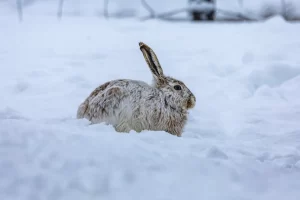Imagine you’re walking through a peaceful meadow, when suddenly you spot a wild rabbit grazing nearby. It’s a magical moment, and you can’t help but wonder if you could befriend this beautiful creature.
Well, the good news is, with a little understanding and patience, you can! In this article, we will guide you through the process of befriending a wild rabbit, from understanding their behavior to gaining their trust and maintaining a long-term friendship.
So, let’s embark on this enchanting journey together!
In This Article
- 1 Key Takeaways
- 2 Understanding Wild Rabbit Behavior
- 3 Creating a Safe and Welcoming Environment
- 4 Gaining the Rabbit’s Trust
- 5 Building a Relationship Through Patience and Positive Reinforcement
- 6 Feeding and Providing for the Rabbit’s Needs
- 7 Maintaining a Long-Term Friendship With a Wild Rabbit
- 8 Frequently Asked Questions
Key Takeaways
- Understanding wild rabbit behavior is crucial for befriending them. Take the time to observe their body language, communication cues, territorial behavior, and natural instincts like scent marking and digging.
- Creating a safe and welcoming environment is essential. Provide secure enclosures, hiding spots, fresh water, and vegetables to entice the rabbit. Introduce yourself by sitting quietly nearby and use positive reinforcement instead of forcing physical contact.
- Gaining the rabbit’s trust requires patience and gradual introduction of treats. Respect their personal space and let them initiate physical contact. Maintain a consistent routine to establish trust and safety.
- Building a relationship with a wild rabbit takes time and positive reinforcement. Establish boundaries, stick to a consistent schedule, use gentle and calm movements, and incorporate playtime and enrichment activities into their routine.
Understanding Wild Rabbit Behavior
You should observe the wild rabbit’s behavior closely to understand its needs and preferences. Understanding rabbit body language is crucial in establishing a connection with these animals. Rabbits communicate through a variety of behaviors, such as thumping their hind legs to signal danger or flicking their ears to show curiosity. By paying attention to these cues, you can gauge their comfort level and adjust your approach accordingly.
Additionally, recognizing rabbit territorial behavior is important. Rabbits mark their territory by leaving scent marks and digging holes, indicating their ownership of a particular area. It’s essential to respect their boundaries and provide them with a safe and secure environment.
Creating a Safe and Welcoming Environment
Make sure to provide plenty of hiding spots and secure enclosures to ensure a safe and welcoming environment for your wild rabbit companion. Creating a bond with a wild rabbit requires patience and understanding.
Begin by giving the rabbit space to acclimate to its new surroundings. Offer fresh water and a variety of fresh vegetables to entice the rabbit to approach. Slowly introduce yourself by sitting quietly nearby, allowing the rabbit to become familiar with your presence.
Once the rabbit feels comfortable, you can start establishing boundaries. Use positive reinforcement to reward desired behavior and gently discourage unwanted behavior. Never force physical contact; let the rabbit approach you on its own terms.
With time and consistency, a trusting bond can be formed, creating a harmonious relationship between you and your wild rabbit companion.
Gaining the Rabbit’s Trust
To gain the rabbit’s trust, start by spending at least 30 minutes a day sitting quietly nearby, allowing the rabbit to become familiar with your presence. This is a crucial step in establishing a bond with a wild rabbit. Here are four key strategies to earn the rabbit’s trust:
- Patience: Be patient and give the rabbit time to approach you at its own pace. Avoid sudden movements or loud noises that may startle the rabbit.
- Offer treats: Gradually introduce small amounts of rabbit-friendly treats, such as fresh vegetables or hay, while maintaining a safe distance. This will help associate your presence with positive experiences.
- Respect boundaries: Respect the rabbit’s personal space and avoid reaching out to touch it until it feels comfortable. Let the rabbit initiate physical contact when it’s ready.
- Consistency: Maintain a consistent routine of spending time near the rabbit daily. This will establish trust and help the rabbit understand that you’re a safe presence.
Building a Relationship Through Patience and Positive Reinforcement
Start by practicing patience and consistently offering positive reinforcement, as these strategies will help build a strong and trusting relationship with the wild rabbit. Establishing boundaries and building a routine are essential in this process.
| Strategies for Building a Relationship with a Wild Rabbit |
|---|
| 1. Establishing Boundaries |
| – Create a safe and secure space for the rabbit |
| – Use gentle and calm movements to avoid scaring the rabbit |
| – Respect the rabbit’s personal space and avoid overwhelming it |
| 2. Building a Routine |
| – Provide regular feeding times to establish trust and dependability |
| – Stick to a consistent schedule to create a sense of security |
| – Incorporate playtime and enrichment activities into the routine |
Feeding and Providing for the Rabbit’s Needs
You can ensure the health and well-being of the rabbit by regularly feeding it and meeting its needs. Here are some key points to consider when it comes to the feeding habits and foraging techniques of rabbits:
- Provide a balanced diet: Offer a mixture of fresh vegetables, high-quality hay, and rabbit pellets to meet their nutritional requirements.
- Monitor portion sizes: Avoid overfeeding as it can lead to obesity and other health issues. Follow recommended guidelines for the appropriate amount of food.
- Encourage foraging behavior: Scatter food around the rabbit’s habitat to simulate their natural foraging instincts. This will provide mental stimulation and prevent boredom.
- Offer a variety of foods: Introduce new foods gradually to prevent digestive upsets. Rotate different vegetables and herbs to provide a diverse diet.
By following these guidelines, you can ensure that your rabbit remains healthy and happy.
Maintaining a Long-Term Friendship With a Wild Rabbit
If you want to maintain a long-term friendship with a wild rabbit, it is important to consistently provide food and create a safe environment. Wild rabbits are sensitive creatures that require certain conditions to thrive and feel secure. Establishing boundaries is crucial to ensure both the rabbit’s safety and your own. It is necessary to respect the rabbit’s natural instincts and not invade its personal space. Recognizing signs of distress is also essential in maintaining a healthy relationship. Rabbits may display behaviors such as thumping their hind legs, growling, or biting when they feel threatened or uncomfortable. By being observant and responsive, you can alleviate any potential distress and foster a trusting bond with your wild rabbit friend.
| Establishing Boundaries | Recognizing Signs of Distress |
|---|---|
| Respect personal space | Thumping hind legs |
| Avoid invading territory | Growling |
| Minimize handling | Biting |
Frequently Asked Questions
Can I Keep a Wild Rabbit as a Pet?
Keeping a wild rabbit as a pet may not be ethical. Rabbits are wild animals and have specific needs that may be difficult to meet in a domestic setting. Consider the well-being of the rabbit before making a decision.
How Can I Train a Wild Rabbit to Do Tricks?
To train a wild rabbit to do tricks, start with gentle training techniques like positive reinforcement and clicker training. Bonding exercises, such as hand feeding and spending quality time together, will help build trust and cooperation.
What Are Some Common Health Issues in Wild Rabbits and How Can I Prevent Them?
To prevent common health issues in wild rabbits, it’s important to identify signs of illness early. Regularly check for weight loss, abnormal droppings, or signs of injury. Provide a balanced diet and a clean, safe environment to promote their overall well-being.
Can I Release a Domesticated Rabbit Into the Wild if I Can No Longer Care for It?
If you can no longer care for a domesticated rabbit, releasing it into the wild is not recommended. Instead, consider contacting wildlife sanctuaries or rehabilitation centers to ensure the rabbit receives proper care and support.





